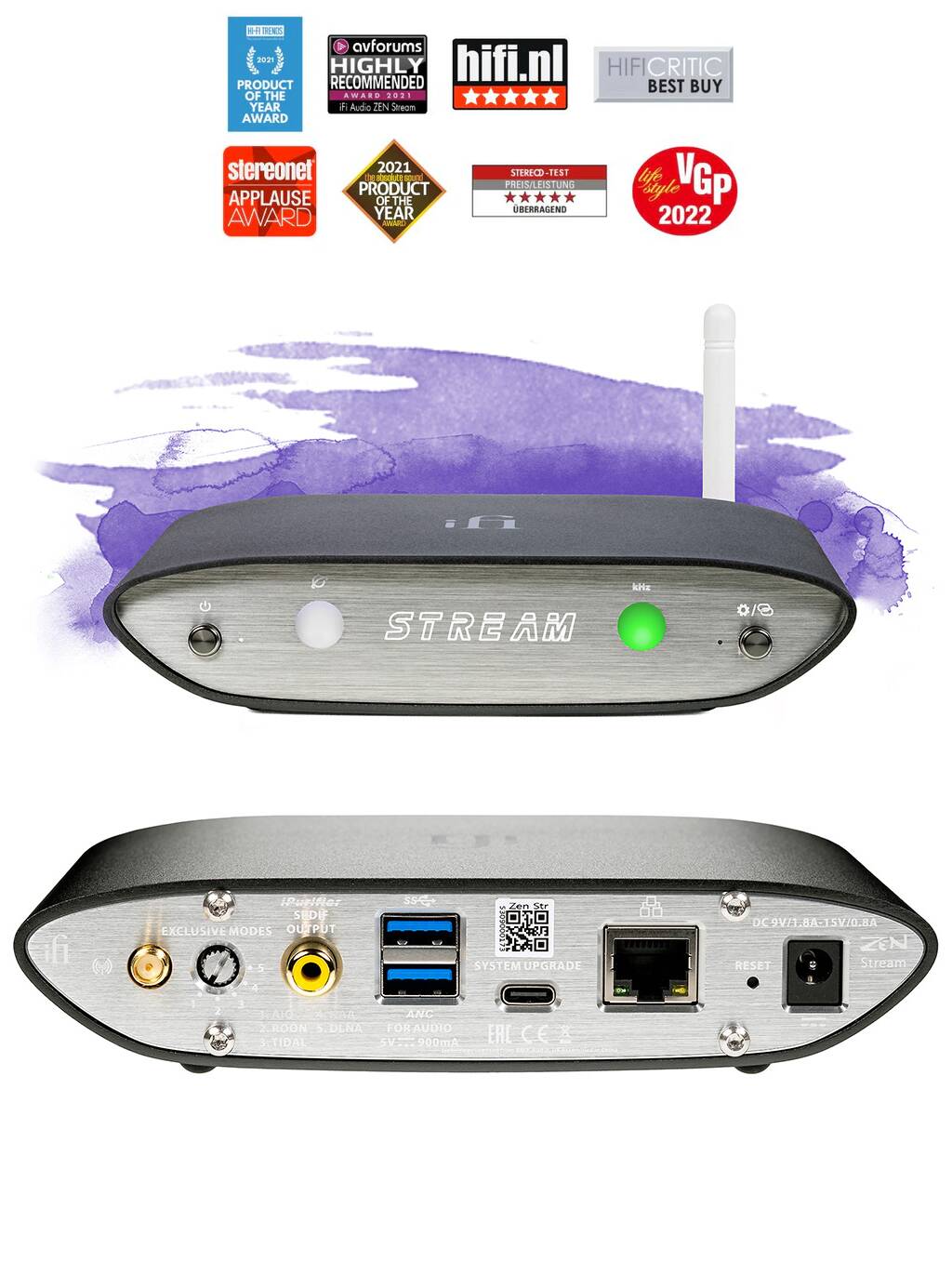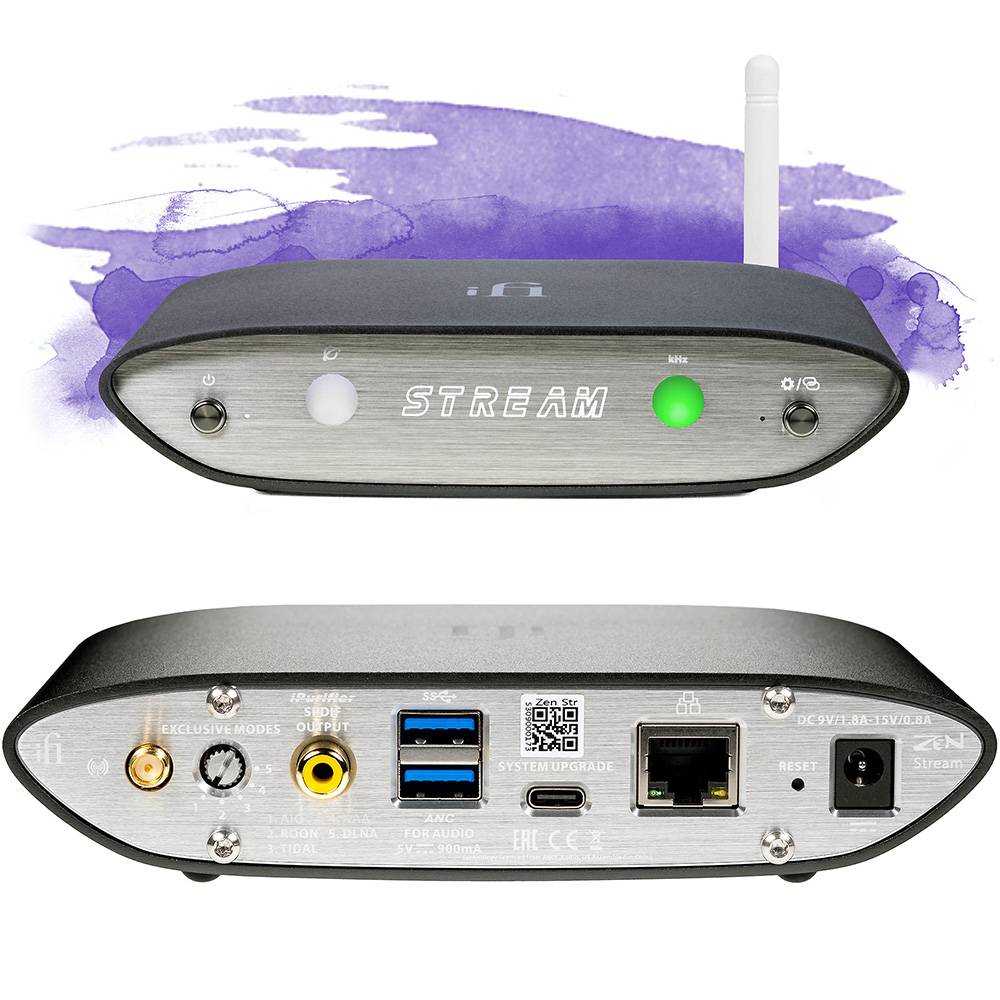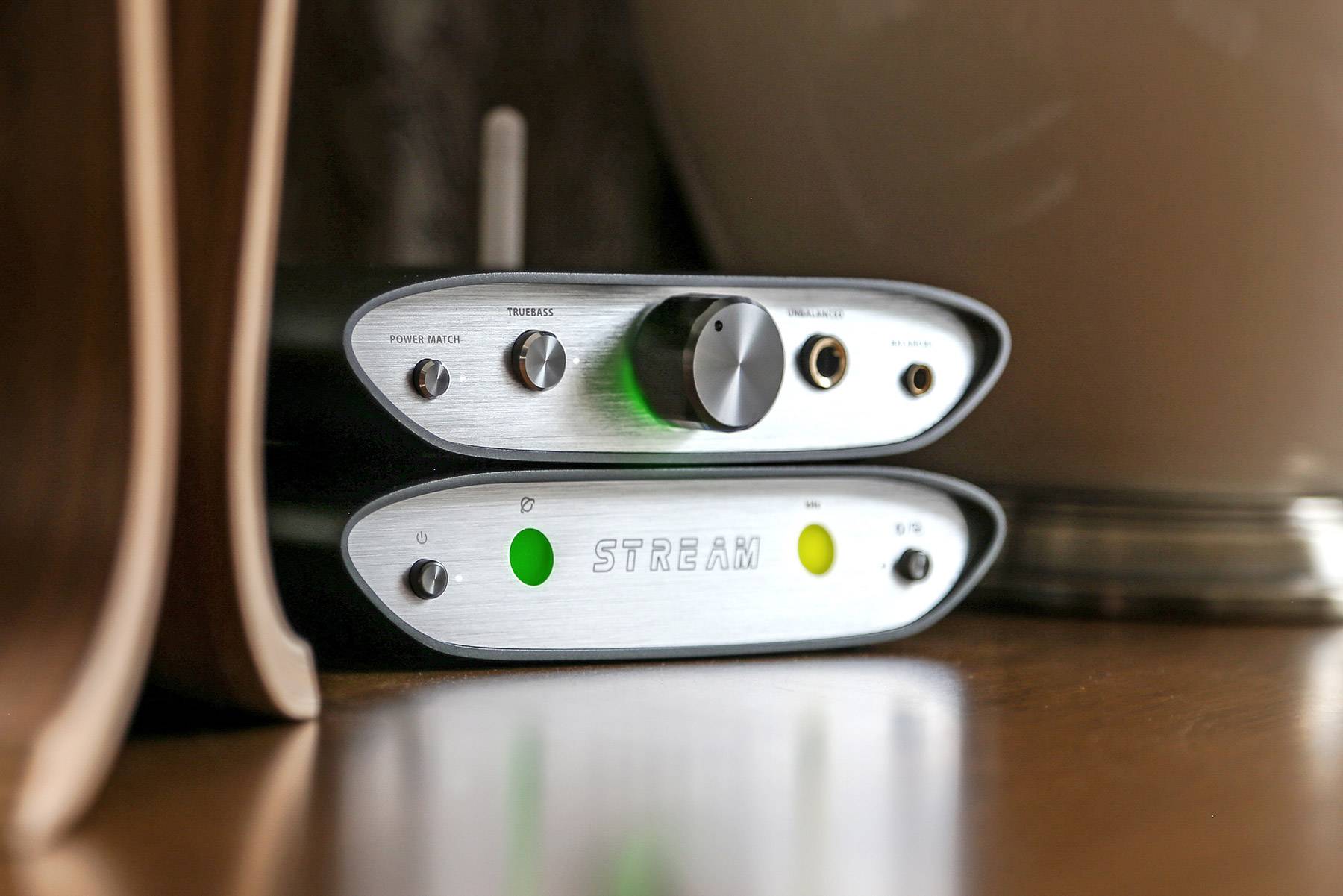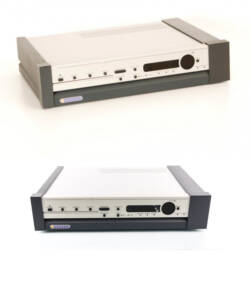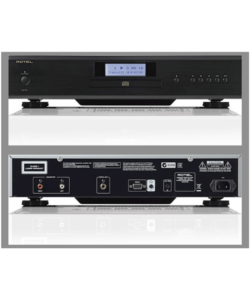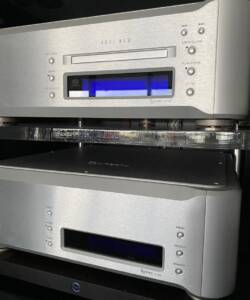iFi ZEN Stream 2nd hand
Original price was: R10,200.00.R6,500.00Current price is: R6,500.00.
Specifications
| DIMENSIONS | 158 x 100 x 35 mm 6.2″ x 3.9″ x 1.4″ |
| FORMATS SUPPORTED | PCM384 DSD256 (MQA passthrough) |
| INPUT | Wi-Fi / Ethernet / USB HDD (Firmware updates via OTA and USB-C at rear) |
| INPUT VOLTAGE | DC 9V/1.8A-15V/0.8A AC 100 -240V, 50/60Hz |
| NET WEIGHT | 578g (1.14 lbs) |
| OUTPUT | USB3.0 (Type-A Socket) x2 SPDIF (Coaxial) |
| POWER CONSUMPTION | No Signal ~6W Max Signal ~10W |
Description
iFi Zen Stream Review
- REVIEW
- by Steven Stone
- Dec 29, 2021

IFi has added another component to its Zen series of entry-level offerings, the $399 Zen Stream. As you might surmise from its name, the Zen Stream is a streaming endpoint. As an endpoint with both USB 3.0 and SPDIF outputs, the Zen Stream can deliver Internet and networked music sources to any DAC with either USB or SPDIF inputs. If you have a great DAC that doesn’t provide a USB input for use with networked sources, the Zen Stream makes that possible.
The Zen Stream supports many streaming sources including Spotify, Tidal, Roon, AirPlay, Chromecast, DLNA, and NAA (Network Audio Adapter) for use with Sygnalist HQPlayer software. You can even plug in a hard drive or thumb drive to use as a music source. The Zen Stream supports both hard-wired Ethernet and Wi-Fi connections. For much less than the price of a pair of premium one-meter cables it allows you to access a universe of music.
Tech Tour
The Zen Stream utilizes a 64-bit ARM Cortex processor as its platform. Its operating system is an open source, just like that of a Raspberry Pi, but unlike a Pi, the Zen Stream comes all set-up for streaming. (Depending on the OS chosen for a Pi, the setup can be fairly simple or quite complicated.) Also, unlike most Pi systems, which do not automatically update when new software is available, the Zen Stream has provisions for OTA (over the air) updates. The Zen Stream supports PCM up to 384/32 and DSD up to DSD256 over both Ethernet and Wi-Fi.

To complement the ARM processors’ capabilities, iFi employs DK C0G multilayer ceramic capacitors, inductors from Taiyo Yuden and Murata, and regulators with high PSRR (power-supply rejection ratio), low idle current, and low dropout voltage. The Zen Stream also employs a synchronous, 1.5MHz, high-speed power-supply controller. One device you will not find in the Zen Stream is a fan; instead, iFi has designed low-profile heatsinks to prevent overheating while maintaining the unit’s compact footprint.
Because it is DLNA certified, the Zen Stream can be supported and accessed by any DLNA-aware device (such as a smartphone player app), and iFi plans to introduce its own dedicated player app. With both Apple AirPlay (now available) and Google’s Chromecast (available via a free firmware update) capabilities, as well as integrated Spotify and Tidal compatibility, the Zen Stream will support virtually any streaming source. While not yet officially certified by Roon, the review sample was recognized by Roon and even supported MQA (by allowing you to specify whether you want the DAC connected to the Zen Stream to be used as a renderer, a decoder, a renderer and decoder, or without MQA support).
The Zen Stream includes a feature iFi calls “exclusive modes.” IFi claims that way it can accommodate “individual settings that deliver fully optimized performance by focusing operation on one particular mode of use.” Options include: “All-in-One,” which is a non-specific mode that is great for all platforms, audio formats, and devices; “DLNA streaming,” which optimizes performance when using the Zen Stream with DLNA-compatible apps and devices; “NAA streaming” for using the Zen Stream as a Network Audio Adapter in conjunction with Signalyst HQPlayer software; “Roon Bridge streaming” for integrating the Zen Stream into a Roon environment; and “Tidal streaming” for subscribers to Tidal’s Masters tier. For users with both Tidal and Qobuz, the Roon mode can fully integrate both services.
Setup
The Zen Stream ranks as the easiest to configure streaming device I’ve had the pleasure of setting up. Since I’m a Roon user, I turned the little rotary setting-dial on the back of the Zen Stream to “Roon,” connected the Ethernet input and the USB or SPDIF output (depending on the DAC), plugged in the Stream’s power supply, turned it on, opened up my Roon app, activated the Zen Stream, and I was good to go. The only bit of weirdness was that Roon called the Zen Stream “Zen DAC.” Since I also have a Zen DAC connected to my main computer’s USB, I needed to manually change the Zen Stream’s name to “Zen Stream” from Zen DAC, so I could tell which device I was streaming to. For a Wi-Fi connection (via either a 2.4 or 5GHz), you need to hold down a button, open a webpage, enter your Wi-Fi password, and you’re all set. For IOS you need to access either http://ifi.local or 192.168.211.1, and then enter your Wi-Fi password in the prompt.
The Zen Stream box package contains a Zen Stream, an Ethernet cable, a plastic screwdriver, the Zen power adapter, a Wi-Fi antenna, an instruction card, and a user manual, all in iFi’s usual elegant little white box.
Ergonomics
When I saw the two outputs on the back of the Zen Stream, I thought, “Cool. I can do A/B comparisons of a DAC’s inputs!” But I discovered that the Zen Stream does not support both outputs being active at once—it gives priority to the USB output, which, when connected, mutes the SPDIF output. And while you can still compare by connecting and disconnecting cables, this will not deliver the kind of switching needed for a real-time A/B comparison. I used the Zen Stream with several DACs, including the new Topping D90SE, the Audio Gd R28 Mark II, the Gustard X-16, and the Gold Note DS-10. With each DAC I was able to successfully use either the USB or the SPDIF connections.
Like many devices, the iFi Zen Stream uses different colored LEDs to show various operating states. Green signifies PCM 44.1/48/88.2/96kHz, yellow PCM 176.4/192/352.8/384kHz, cyan DSD64/128, blue DSD256, and off when receiving no input. There is also an LED for hotspot (network) status: When flashing on and off, it’s awaiting connection; on when a hotspot is connected; and off when there is no current hotspot.
Once it was configured and connected, I found the Zen Stream a “set and forget” device. I did not have to adjust or tweak my initial setup. Even after power outages, the Zen DAC did not require any user-assisted reboots. It merely needed to be turned back on to successfully reconnect to the DAC and streaming sources.
I’ve read a great deal in these pages and elsewhere about Ethernet tweaks and devices to lower “noise” from streaming network sources. I do not currently employ any Ethernet noise-reducing devices. My system is “hard-wired” with standard CAT5 Ethernet cable throughout. While I have tried various products that proffered lower noise, I have not noticed any sonic changes when they were employed. But there may be a very good reason why network tweaks don’t have an effect in my system. I have FIOS (fiber-optic network) Internet service running directly into my high-speed modem (currently 100mps upload, and 50 download). Fiber-optic networks, unlike copper-cable networks, do not have the potential to act as giant antennas. So, the RF noise level is potentially lower, and there is less, if any, noise that needs to be filtered out. I would encourage anyone with the option of switching from copper cable to FIOS to do so. It may well be the best Internet streaming “tweak” currently available.
Sound
This might be the ideal time to pose the question, “Do streamers have a sound?” They are basically file movers. They move digital data, which in this case happens to be music, from point A to point B. Music files enter via Ethernet or Wi-Fi and are sent to a DAC. Ideally nothing should alter their contents or error-rate. Whether there are functions or factors within the network signal chain that can or do alter the final results appears to be a subject that inspires passionate and polarized debate. My position is pragmatic. A simple, well-designed, robust streaming-signal chain should not have an audible effect on the sound of a music file.
I compared the Zen Stream with both a Raspberry Pi4b and with the internal Ethernet connection in the Gold Note DS-10 Plus, using Roon as my source app. Since Roon allows “ganging” endpoints so they can all receive the same music at exactly the same time, A/Bs were real time. I used music from both Tidal and Qobuz, as well as my own live concert recordings of the Boulder Philharmonic (some made assisting J. Gordon Holt) and of small acoustic ensembles, such as Mr. Sun and The Deadly Gentlemen made at the Salina Schoolhouse. After setting up a quasi-blind test procedure to ensure that I did not know which signal was which, I could not reliably tell one feed from the other. Maybe I’m just a deaf old guy, or maybe there were no differences. You choose…
Competition
When it comes to streaming, there are many ways to do it. You can employ a flagship streamer in a system that rips CDs and contains your music library internally on drives. Conversely, you can also configure a minimalist Raspberry Pi and have your entire music library in the cloud. It all boils down to your lifestyle and how you want to control and access your music.
Obviously, the iFi Zen Stream is a building block rather than a complete music-streaming solution. It requires an Internet connection on its input and a DAC on its output. The advantage is that you can combine it with a wide variety of sources and destinations, while maintaining a high level of operating simplicity and compatibility.
One alternate streaming device option for some could be the Bluesound Node ($549). It offers the addition of a solidly designed and road-tested, closed operating system, analog outputs, and Bluetooth inputs. If you need Bluetooth, iFi offers its Zen Blue ($159), but that puts the Zen combination-price above that of the Node. And there is Sonos, but it does not support higher-resolution files, and its tech and interfaces options are clearly outclassed by both Bluesound and iFi.
Summary
Unlike many streaming components that attempt to do many things, the iFi Zen Stream does only one thing: Deliver music from virtually any streaming or network-connected music file server to the DAC of your choice. It has no file-size, file-type, or library-size limits. Depending on how you configure the Zen Stream, it can be fine-tuned for a particular streaming methodology, platform, or playback app.
For Roon users, the Zen Stream offers an inexpensive no-fuss Roon endpoint, or potential multiple endpoints, as you add additional Zen Streams to different rooms. For owners of DACs that don’t have a USB input option, the Zen Stream offers an SPDIF digital-output connection, so virtually any DAC can be used with the Zen Stream.
I own and regularly use four Raspberry Pis that have been configured with different systems and optimized for music streaming. After using the iFi Zen Stream, I seriously doubt I will bother configuring another Raspberry Pi. The Zen stream is far easier to set up, more user-friendly, and sonically indistinguishable. It is almost four times as expensive as a Pi, but for all but the savviest computer user, the Zen Stream may well be the most hassle-free, flexible, and high-quality music streamer currently available.
Key Features




Just add Remote Control
Beneath its classy exterior, the ZEN Stream is a technological streamer-de-force. It has one purpose – to send music simply from the Internet to your DAC with no loss of quality. True hi-res performance of PCM384/DSD256 via WiFi/LAN. Just add your smart device as a remote and away you go. Ease of use + audiophile implementation. Follow our simple set-up guides on YouTube. It is the bee’s knees of Streamers.

Warp speed tech
ZEN Stream is a true ground-up design by iFi — the hardware and software implementation is quite exceptional: Two SuperSpeed USB3.0 ports with Active Noise Cancellation II, S/PDIF out with the iPurifier built-in, iFi software developed with Volumio open-source as the starting point, then coded and optimised by us to achieve the purest streaming software bar none. These are some of the factors behind why the ZEN Stream is at the cutting-edge handling PCM384/DSD256 on LAN and WiFi (802.11n, with 100Mbps on 5Ghz).


Tech savvy
Beneath the unassuming casework sits some serious horsepower in terms of both technologies and components:
- Powerful 64-bit quad-core ARM Cortex microprocessor
- USB and S/PDIF interfaces regulated by femto-precision GMT clock to eradicate jitter
- Active Noise Cancellation II and iPurifier technologies for USB and S/PDIF interfaces respectively
- Intelligent Ethernet switch controller
- High-PSRR, low idle current, low-dropout voltage regulators with soft start
- Synchronous 1.6MHz high-speed precision power supply controller
- C0G capacitors and Taiyo Yuden and Murata low ESR inductors

‘Exclusive’ for your ears only
The ZEN Stream features a fully optimised software platform, from drivers and kernel to applications and user interface, ensuring seamless operation and superb sonic performance.
Its ‘Exclusive’ modes focus on specific functions like ROON Ready, Tidal, NAA, and DLNA streaming, removing unnecessary programs to reduce ‘software jitter’ for pure performance. All-in-one (AIO) mode covers all functions, making the ZEN Stream a master of all.

Superb sound, no matter how you stream
The ZEN Stream’s hi-res audio credentials are top-notch, supporting PCM up to 32-bit/384kHz and DSD up to
11.2MHz (DSD256) over Wi-Fi – highly unusual – as well as over Ethernet cable. There are multiple ways in which the device can interface with your music collection or favourite streaming service, depending on the user’s preference, and thanks to the ZEN Stream’s open-source architecture these will expand over time.
DAC’s your perfect partner

Because the ZEN Stream is a network audio ‘transport’, as opposed to a ‘player’ – it outputs a digital signal rather than an analogue one – it can be combined with whichever DAC (Digital-to-Analogue Converter) the user prefers.

An obvious partner is iFi’s ZEN DAC – an affordable, multi-award-winning USB DAC with balanced circuit design and the same 158x35x100mm aluminium enclosure.


